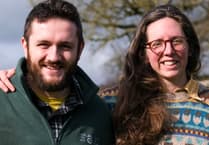A successful scientific and community aid expedition led by Colonel John Blashford-Snell, has just returned from Mongolia. The group of 24 self-funded volunteers, included Stewart Morehead of Llangrove. The travellers enjoyed seeing the rare Przewalski Horse and endangered Saiga Antelope. The team were riding local horses and travelled miles in order to view some remarkable paleolithic era rock paintings, bronze age burials and wide range of plants, birds and mammals.
While in Mongolia they carried out dentistry and medical work, (all expeditions include a doctor and a dentist) distribution of reading glasses and gave gifts including books, dolls and puppets.
Stewart told the Ross Gazette that when he was told about the expedition by a friend who also lives at Llangrove, he was intrigued. He is fond of outdoor activities and was able to meet the two main pre-requisite of taking part – an ability to ride horses properly and to be happy to eat anything offered.
He said that the Mongolian people, who are nomadic, are also very hospitable. They invited the travellers into their homes and offered refreshments in a very strict order. First Stewart said they had warm yak’s milk, then yak’s curd, then yak’s tea and finally mare’s milk vodka. He said they have strict rituals and you have to accept them.
Stewart’s main job was acting as quartermaster responsible for equipment. This included field radios, GPs devices and 200 pairs of specatles which were given out during the trip. He said these are just straightforward magnifying glasses but they transformed lives. The dentistry work also made a huge difference to people, but Stewart told the Gazette that they used the gifts of toys and dolls to persuade the children to be examined by the dentists.
Each member of the team had daily tasks as they were part of different groups carrying out research into zoology, botany and archaeology. They even discovered a burial site.
He said they visited areas where people have not been before, reaching heights of 13,000 feet. Several members of the group experienced altitude sickness, even at the camps, which were at 11,000 feet.
See the full story in this week’s edition of the Ross Gazette, or subscribe to our online edition here




